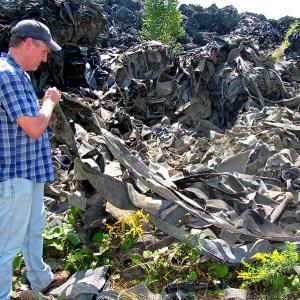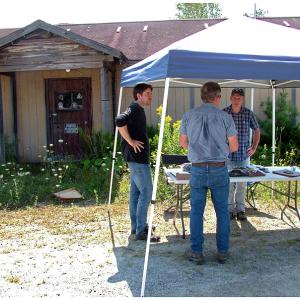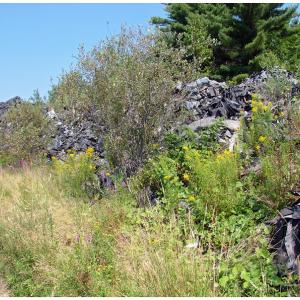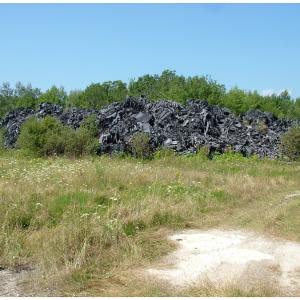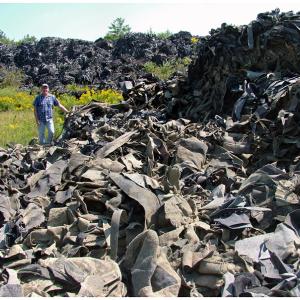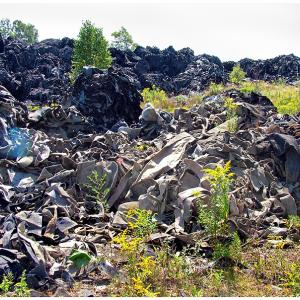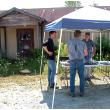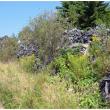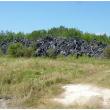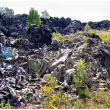DEP seeks creative reuse ideas for ... all this stuff
 Michael Parker of the Maine Department of Environmental Protection lifts some of the synthetic upholstery stockpiled on the property of a defunct shooting range in Warren. DEP is seeking proposals for reusing the material, which currently poses a fire hazard. (Photo by Ethan Andrews)
Michael Parker of the Maine Department of Environmental Protection lifts some of the synthetic upholstery stockpiled on the property of a defunct shooting range in Warren. DEP is seeking proposals for reusing the material, which currently poses a fire hazard. (Photo by Ethan Andrews)
 A group poses questions to Michael Parker of the Maine Department of Environmental Protection at a bidders conference held at the former shooting range, Aug. 21. (Photo by Ethan Andrews)
A group poses questions to Michael Parker of the Maine Department of Environmental Protection at a bidders conference held at the former shooting range, Aug. 21. (Photo by Ethan Andrews)
 Heaps of the polyester and polypropylene material line an access road leading back into the 70-acre property. (Photo by Ethan Andrews)
Heaps of the polyester and polypropylene material line an access road leading back into the 70-acre property. (Photo by Ethan Andrews)
 One of a number of massive heaps of the material remnants of upholstery used in automobile trunks. (Photo by Ethan Andrews)
One of a number of massive heaps of the material remnants of upholstery used in automobile trunks. (Photo by Ethan Andrews)
 A portion of the largest piles of scrap fiber material on the former shooting range. (Photo by Ethan Andrews)
A portion of the largest piles of scrap fiber material on the former shooting range. (Photo by Ethan Andrews)
 A view in the opposite direction from the previous photo. (Photo by Ethan Andrews)
A view in the opposite direction from the previous photo. (Photo by Ethan Andrews)
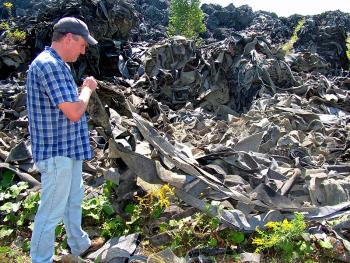 Michael Parker of the Maine Department of Environmental Protection lifts some of the synthetic upholstery stockpiled on the property of a defunct shooting range in Warren. DEP is seeking proposals for reusing the material, which currently poses a fire hazard. (Photo by Ethan Andrews)
Michael Parker of the Maine Department of Environmental Protection lifts some of the synthetic upholstery stockpiled on the property of a defunct shooting range in Warren. DEP is seeking proposals for reusing the material, which currently poses a fire hazard. (Photo by Ethan Andrews)
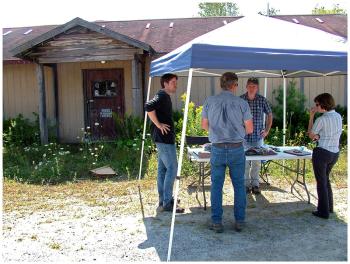 A group poses questions to Michael Parker of the Maine Department of Environmental Protection at a bidders conference held at the former shooting range, Aug. 21. (Photo by Ethan Andrews)
A group poses questions to Michael Parker of the Maine Department of Environmental Protection at a bidders conference held at the former shooting range, Aug. 21. (Photo by Ethan Andrews)
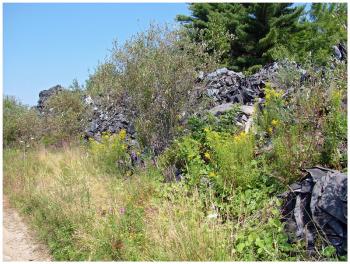 Heaps of the polyester and polypropylene material line an access road leading back into the 70-acre property. (Photo by Ethan Andrews)
Heaps of the polyester and polypropylene material line an access road leading back into the 70-acre property. (Photo by Ethan Andrews)
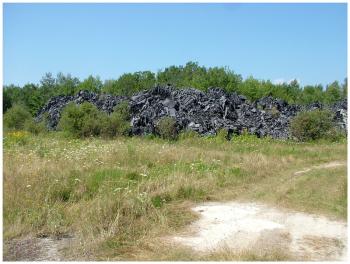 One of a number of massive heaps of the material remnants of upholstery used in automobile trunks. (Photo by Ethan Andrews)
One of a number of massive heaps of the material remnants of upholstery used in automobile trunks. (Photo by Ethan Andrews)
 A portion of the largest piles of scrap fiber material on the former shooting range. (Photo by Ethan Andrews)
A portion of the largest piles of scrap fiber material on the former shooting range. (Photo by Ethan Andrews)
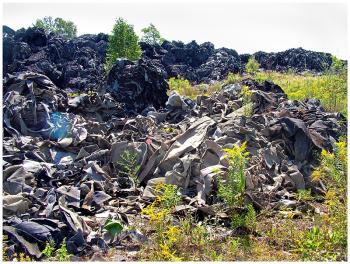 A view in the opposite direction from the previous photo. (Photo by Ethan Andrews)
A view in the opposite direction from the previous photo. (Photo by Ethan Andrews)
WARREN - “Think of this as cookies,” said Michael Parker, project manager with the Maine Department of Environmental Protection. “You roll out the dough and stamp out the cookies and this is what you have left.”
Parker was standing on the back lot of a defunct shooting range on Route 90, surrounded by mountains of fuzzy polyester and polypropylene upholstery — remnants of the material used to line the interiors of automobile trunks.
His hope is that someone will have an idea of what to do with it.
The material was originally brought to the property by the truckload as cheap fill for earthen berms intended to mute the sound of gunfire. At least one of these was competed, but according to DEP 80-percent of the material remains uncovered and currently poses a serious fire hazard.
The Department estimates there is 27,000 tons of the material. For a local comparison, that’s around 7,000 Hope Elephants.
After failed attempts to get to property owner to deal with the material, Parker said DEP was able to get money for remediation by placing a lien on a settlement between the owner and a bank with an interest in the property.
DEP has since issued a request for proposals to have the material turned into an alternative fuel for industrial boilers or for some other “beneficial use.” Proposals are due in the middle of next month.
Parker was on site August 21 for an informational bidders conference. Representatives of ten businesses attended and Parker said the Department has received 20 requests for the RFP to date.
The RFP includes three options for bidders. The first two involve converting the 27,000 tons of fiber material into an alternative fuel for use by Dragon Products in Thomaston or another industrial facility with an option to also transport it.
“The reason Dragon was named specifically [in the request for proposals] is that they came to us and said they wanted to burn this stuff,” Parker said. “But it could go to another industrial boiler.”
The third option is to do something else that would clear the material from the site and result in it being reused it in a way deemed beneficial by the Department.
Parker said the material is stable and does not decompose. In this way, it would not contaminate soil or water, but digging a hole and burying it isn’t going to get the thumbs up from DEP either, he said.
One attendant of the bidder’s conference on Wednesday asked about the insulating properties of the material. Another asked how well it would work for drainage. These would fall under the catch-all category of “other beneficial use.” The emphasis by DEP on processing the fabric for alternative fuel, Parker said, comes from its inherent flammability, which he likened in the scope of DEP enforcement to heaps of tires.
“That’s its biggest hazard and its biggest asset,” he said.
Bidders who didn’t attend the conference may submit written questions to the Department by August 26, 2013. Proposals are due by September 18, 2013 at 2 p.m.
A link to the RFP is on DEP's website here: http://www.maine.gov/dep/rfp/rfp.html?id=576517. For more information please contact Michael Parker at 287-7704 or at michael.t.parker@maine.gov
Ethan Andrews can be reached at news@penbaypilot.com
Event Date
Address
United States

